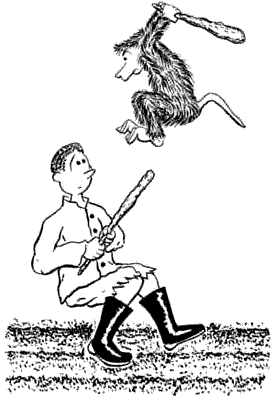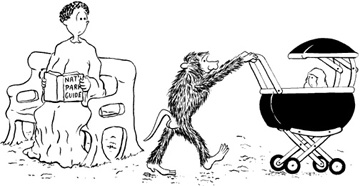

Threatened, Endangered, and Vermin
Of all the primates, baboons have certainly gotten a bad rap. After all, when the scriptwriter of "The Sands of the Kalahari" wanted the bad guy to get eaten up, he called in a troop of baboons. When the creators of a popular animated cartoon series needed a moronic sidekick for an articulate and intellectual weasel, they picked a baboon. Then there's the hit prime time series where the young daughter yelled that her father was a "stupid, ugly baboon", which caused her dad to lament that she had branded him as the "smelliest and ugliest of the apes." A triple insult, considering baboons are neither smelly, ugly, nor apes.
But probably the biggest slap on the snout came when the African Convention on the Conservation of Nature and Natural Resources was drafted in 1968. When it came time to classify the species - whether vulnerable, threatened, or endangered - monkeys, gorillas, and chimpanzees were all dutifully listed.
But just how did baboons rate? Endangered? Threatened? Vulnerable?
Nope. Not even close.
Baboons were just plain vermin.
Yes, you heard right. There's no trick wording here. Baboons were tagged as vermin, just like rats, mice, locusts, and corporate CEO's. This was bad news since it meant the animals could be hunted with virtually no restrictions. Prospects did brighten a bit in the mid-1970's when two types of baboons were listed in the Convention on International Trade in Endangered Species (CITES). Some countries also began dubbing them "problem animals", and you're supposed to call in a game warden if they get rambunctious. But then in January 2002 it was reported from Uganda that baboons outside of game reserves were again being classified as vermin.

The African Convention
So how did baboons, whose ground dwelling and complex multi-layered society makes them as much like our early human ancestors as any other primate, end up so they might pass into extinction without the courtesy of an intermediate classification? Well, there are a number of reasons. Although one by one the problems might not necessarily lead to difficulties, taken together, they can result in a group of cantankerous, ornery animals and some very irritated people. When you have that, you have vermin.
First there are the sheer numbers. Some estimates state there may be up to half a million of a given species in a single country. With five species scattered throughout Africa and into Asia, you easily have enough baboons to populate a modern city.
Reason number two is adaptability. When humans began to build farms, schools, and villages, baboons didn't flee to the uninhabited forests and savannahs like other primates. Instead, they fit right in. After all, food in cultivated fields is more abundant, easier to pick, and tastes better than the plants, grubs, and insects that zoologists tell baboons make up their "natural" diet. This, then, brings us to reason number three. As far as baboons are concerned, this farmland produce is theirs by right since it is obviously being provided by their social inferiors.
Yes, baboons consider people their social inferiors. When "civilized" people began visiting the African national parks, they just couldn't help feeding the animals. This continues today, with the visitors continually offering tidbits to the baboons despite the posted signs and warnings from the game wardens. Thinking in terms of their own tail-wagging dogs and purring cats, the tourists naturally expect the animals will be duly grateful and think of humans as benefactors to the natural wildlife. But baboons don't quite see it that way.
For a baboon the uppercrust always eats first. The lower you are in the troop pecking order, the later you eat. So if you actually feed a baboon, you are unintentionally relegating yourself to the lowest level in the primate hierarchy. As the years have passed, the baboons have come to expect handouts as their rightful due and can become quite irritated when they are not forthcoming.
But baboons believing tourists are their personal valets is not the real problem. What is the problem is the baboons carry this attitude with them as they wander away from the national parks and into areas where modern agriculture and livestock breeding are replacing the traditional nomadic and pastoral lifestyles. There the baboons' idea that the food is being raised for their own personal benefit does not sit very well with the local farmers and herders trying to make a living.
Incidents of man versus baboon are regularly reported in the press. In some regions, baboons are reported to ransack homes and snatch chickens, goats, and other small livestock. The tried and true method for handling such intrusions, that is, making noise and shooing the interlopers away, isn't always best for dealing with baboons. Unlike most animals, baboons are quite capable of learning from their human neighbors and have no hesitation to responding in kind.
A young man who learned this the hard way was John Oluka of Uganda. When he saw a baboon in the family garden, he picked up a stick and started to drive the animal away. Instead of scampering off, the animal turned the tables on John, grabbed the stick and began to flog him as a number of incredulous villagers looked on.

The baboon turned the tables on John.
Similar reports extend beyond the borders of Africa. Saudi Arabia is particularly baboon prone these days, with tales of baboons raiding farms, houses, and even schools. But probably the strangest report was where a troop deliberately wait in ambush. According to newspaper accounts, a local resident, driving along the road from Mecca to Taif, accidentally struck one of the baboons living along the side the road. Although the driver may have felt a bit bad about it, he drove on and probably didn't think much more about the matter.
But when he returned three days later, he had quite a surprise. As he passed by the same spot, a "sentinel" animal screeched out a warning, and the whole troop began pummeling the driver in a frenzy of stone throwing. Although the vehicle sustained considerable damage, including a broken windshield, the driver managed to escape.

When he returned three days later, the driver had quite a surprise.
It cannot be overemphasized that these problems have gotten worse in recent times as droughts, wars, and famine have continued to plague Africa and Asia. As times get harder, the animals leave the game reserves looking for better pickings. Then the conflict between man and monkey can become extreme.
In Kenya, for instance, a group of villagers, who were drawing water from an emergency supply, were attacked by a group of "monkeys". Although the reports didn't definitely specify the animals were baboons, their behavior, which included stone throwing, suggested they were. The two bands fought over the disputed water tanks for two hours, and in the end ten villagers were hurt and eight monkeys were killed.
A similar fray broke out in Jarra, Gambia, where local inhabitants, tired of the raids on their farms and village, finally declared all out war against the local baboons. Not content with driving the animals from the fields, the villagers pursued them into the forests, attacking any animal they found. Despite a thundering editorial in the Banjul Independent in support of the baboons, solutions were slow in coming. The procrastination prompted another editorial, and since then conservationists have stepped in to try to work out a solution.

In Jarra, Gambia, the tensions broke out into open warfare.
As strange as some of the tales are, many can be verified. However, others are pure bullshine. A report that a troop of baboons in South Africa's Lawrence De Lange Nature Reserve had adopted a human child turned out to be bogus. Other reports, too, can be the result of deliberate fraud initiated by hunters, poachers, and pranksters. Such was the case in Swaziland where baboons were accused of soliciting.

The story that the baboons had adopted a human child turned out to be bogus.
It seems that a number of women and girls from a village near Nhlangano began reporting that baboons were breaking into their homes while their husbands were away. According to the women, the animals were smashing down doors and insisting on amorous attention. Oddly enough the baboons screamed their demands in English, not the local native dialect. The attacks went on for almost a year and literally drove some of the women from their homes.

Baboons in Swaziland have even been accused of soliciting.
In short order, the lusty baboons of Swaziland became the country's hot political issue. Some lawmakers claimed their country's tough conservation laws had gone too far and were putting the welfare of animals above the safety of the people. Conservationists quickly jumped in and said the politicians just wanted to return to the old days of unrestricted hunting which would destroy Swaziland's natural resources. Social and educational divisions also began to creep in with the more affluent and educated citizens claiming the episode was nothing more than mass hysteria prompted by traditional beliefs that baboons are emissaries and assistants to witches and sorcerers. The local leaders in turn were quite miffed by what they considered a condescending brush off of a serious problem and vowed to take care of the matter themselves. Fortunately, cooler heads prevailed, and the local Hluthi police set up a stake out. Soon the matter was cleared up once and for all.
It seems the "baboons" were simply three rambunctious young boys from the village, aged 12 to 16, who had dressed up in baboon skins. Pleas of youthful high spirits fell on deaf ears to the very irritated authorities, and the oldest two were given a choice of two years in jail or a hefty fine. That put an end to the randy baboons of Swaziland.
So, then, just how dangerous are these "problem animals"? Certainly baboons, like any wild animal, can be formidable if not treated with respect. But even a cursory examination of the statistics reveal that most animals - even domesticated ones - also cause serious injuries and even fatalities. There are, for instance, about four million (yes, million) dog attacks each year in the United States alone. Perhaps 20 of these will be fatal. Bear and shark attacks, always popular stories with the mainstream media, occur regularly, with perhaps 1 to 2 people killed every a year or so. Similar statistics can be cited for other species.
But statistics don't set very well with the local inhabitants of Africa or Asia. A farmer in Uganda could care less that there are four million dog attacks in the United States. American dogs don't trash his farm. The baboons do.
As of yet, there is no single solution that works perfectly. Inflatable scarecrows, automatic noisemakers, and solar powered electric fences, which are fine for some species, are not as effective with baboons. Planting crops the animals won't eat works in principle, but you can't expect an entire country to begin raising chili peppers.
A related method, called conditioned taste aversion (CTA for short) shows promise. In CTA a small part of the crop is kept separate and spiked with something that makes the animals so nauseated they never want to eat that type of food again. Although CTA has been shown to be highly effective in species from crows to wolves, the intelligence of baboons throws a monkey wrench (no pun intended) into the plan. The problem is that the most popular CTA "spike", lithium chloride, is so salty that the baboons can detect it after the first nibble. Rather than eat the rest of the fruit, they simply throw it away and seek out the untreated plants.
Probably with two such headstrong species as man and baboon, the two groups just need to stay apart. Relocation - that is physically moving the animals away from human settlements - has had some success. But relocation takes time and money which are scarce commodities in developing countries. Ultimately it may just postpone the problem. Eventually civilization will creep into the unsettled areas, and unless the animals are specifically moved to a game reserve, everyone will be back where they started.
To fit the pocketbook of the countries where baboons thrive, lower tech passive solutions might have a better chance at working. In Uganda's Kibaale National Park, for instance, the expedient of constructing trenches bordered with mauritius-entwined eucalyptus trees is being tested to see how it will keep the baboons and other animals happily in the game parks and off the farms. If the barriers are monitored for weak spots and times don't get so tough that the animals will force their way through anything, this seems to work.
But then there are still the tourists. They really do need to start obeying the signs and warnings. If nothing else maybe the baboons can finally accept people as their equals - and not as a bunch of useless vermin.

Useless vermin